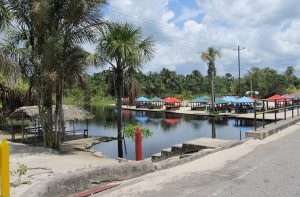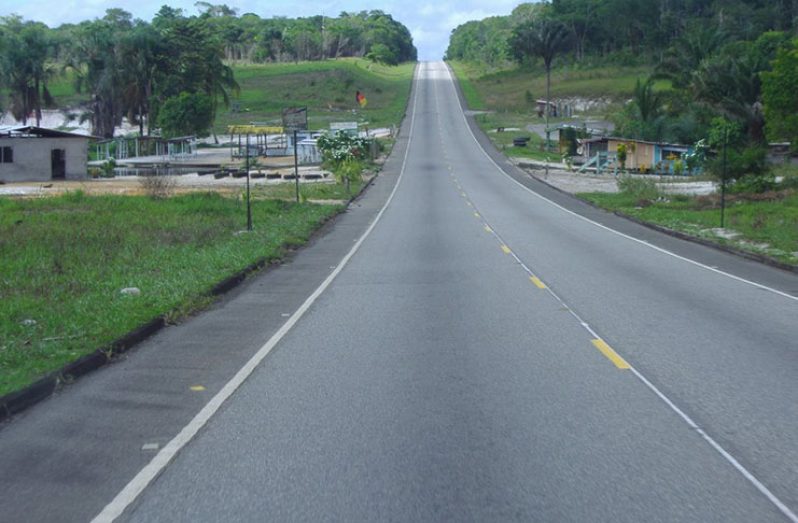SINCE the completion of its construction in 1969, the Soesdyke-Linden Highway, a 45- mile uninterrupted stretch of bituminous road which connects Region Four (Demerara-Mahaica) to Region 10 (Upper Demerara-Berbice) was a blessing to many, especially residents of Linden, formerly known as Mackenzie. The days of having to take a long and tiring journey on the waves of the Demerara River in a vessel was over, and with ready transportation, one can now journey to Linden is a mere 1½ hours, or even less, depending on the traffic, and the speed at which the driver chose to travel.
Linden, as a town, benefitted tremendously economically, and by extension the entire country, as the ‘Highway’ allowed better access to interior locations through the mining town.
In time, several villages were developed along the highway, and while the inhabitants were predominantly Amerindian, these villages expanded and now there are several schools, churches, businesses and even a vocational college at Kuru Kuru.
HIGH PRAISE
The plethora of benefits to be derived from the construction of the highway some 47 years ago was nothing short of a blessing, and the Government of Guyana came in for high praise for undertaking this great project.
Only five years before the highway was completed, over 40 Lindeners lost their lives while travelling from Georgetown to Linden on the MV Son Chapman; the memory of that fateful day was still fresh in the minds of Lindeners, and fear still lingered in their hearts every time there was a need to sail to Georgetown.
With the construction of the highway, boat captains and owners were now looking for a new way to earn a living, while private buses began plying the route.
But while the road was seen as a convenience in some aspects, that feeling quickly turned into fear, as vehicular accidents began to spiral. Since then, several Lindeners and persons from elsewhere have lost their lives in vehicular accidents on the Linden Highway. Some of these accidents saw as many as six persons dying on the spot.
While most of those accidents were caused by speeding, resulting in head-on collisions, others were caused by blow-outs, hit-and-runs, and in one particular case, a bus bursting into flames, killing four young schoolchildren on the spot.
NO LONGER A BLESSING
The highway was now seen not as a blessing, but as a deadly roadway, as, every year, many lives continue to be lost as persons commute from Georgetown to Linden.
As a resident of Linden, one is often cautioned:
“Be careful on that highway!”

“Don’t travel late on that highway!”
“This hour you travelling on the highway!!” “Don’t let dark catch you on that highway!” For those students and workers having to travel to and from Linden every day, prayers are a must, as one does not know if he or she will make it off of the highway safely. These concerns have grown lately, as the accident toll on the highway continues to spiral, with six persons having lost their lives in 2016. These exclude the scores of accidents that were not fatal.
The road having been rehabilitated during 1997-1999, no other major repairs have been done since then.
STRUCTURAL FAULTS
Drivers and regional authorities have all described the current state of the highway as deplorable, and in dire need of repairs. Several structural faults, indentations and eroded sections can be seen on the highway, and drivers doing over 100km who are not au fait with these faults can run into problems.
In the absence of vehicles on the Linden Park in Georgetown, residents would prefer to wait until a known and experienced driver turns up on the park rather than take a gamble and travel with someone who is not from Linden and is not a regular driver on the highway.
Said one regular traveller: “Me! I does travel every day to go UG! It could be after nine in the night, and some Timehri bus or car pull up, I prefer to stand up till eleven rather than to go with a strange driver; because, if they don’t know the highway, especially at nights, it can be very detrimental.”
Similar sentiments were expressed by a minibus driver, who posited that the shift in the foundation of the highway has resulted in several bumps and holes along the way, and only someone familiar with these faults can drive smoothly on the highway.
“If you ain’t know them bad spots,” he said, “you would bump up all the time, and it is impossible to drive straight through on your lane, because of the state of the road.
“And that is what does cause accidents, because sometimes you trying to avoid a bad spot, and crash into something, especially in the nights.”
According to Mark, a conductor: “The highway weary, man! It tired! It need a complete do-over, or we will continue to get accidents all the time.”
One of the indentations at reference that was recently recapped, caused three accidents on the same spot in the vicinity of Bamia last year.
NO LIGHTING
Another major concern for road users and drivers is the absence of lights and reflectors on the road. With a driver having to exclusively depend on their vehicle’s head lamps for visibility, the reality of this is very frightening.
Several calls have been made for the placement of lights along the highway, as it is almost impossible to see your way through, especially during heavy fogging. For an experienced driver, the ordeal might be less frightening, but for someone unaware of the curves and bends of the highway, driving off of the road is an almost reality.
Councillor Charles Sampson calls it a veritable death trap. Said he:
“If it’s raining and you coming through that highway in the night, it’s just God’s mercy that does bring you through…
“Apparently, dem ‘big-boys’ gotta come and drive li’l bit more in the night! It’s a nightmare if you coming through! When you hit Moblissa Road, you don’t know whether you in the corner or you in the middle!
“And if a light coming against you, you in trouble! It’s just by the grace of God you hold yuh wheel straight, and you sail pass the vehicle!”
Peter Alleyne, of Mahdia, Region Eight (Potaro-Siparuni) was driving his minibus on the evening of October 29 when he crashed into a parked truck, killing his wife, Bridget, and Royston Holder, a passenger, instantly.
Peter believes that if there were lights on the road to help with visibility, the accident would not have happened. “I was driving at a pace of 60 kilometres per hour when I collided with the truck,” he said.
“There were no reflector lights or anything to enhance by visuals, and the truck was not visible to my naked eyes…
“It was not until I had almost collided with the truck that I realised that a lumber truck was parked in front of me.”
Also absent on the thoroughfare is road markings and signage, which can also aid drivers and other road users.
Four lives have already been lost since the break of 2017 on the highway, and if these issues are not corrected by the Ministry of Public Infrastructure, there is the belief that the highway will continue to be a death trap, snatching young lives.




.jpg)










